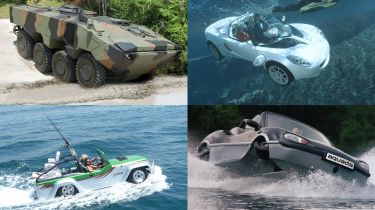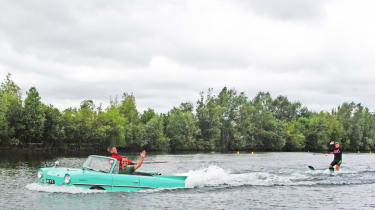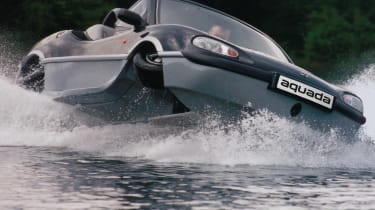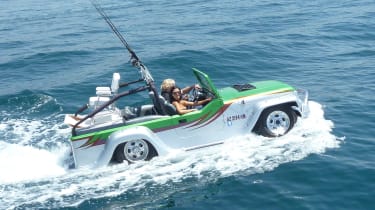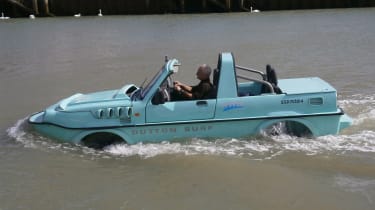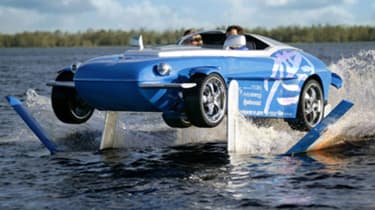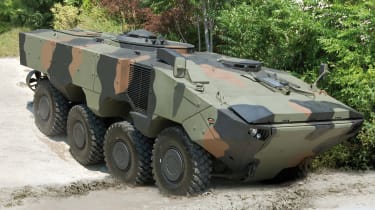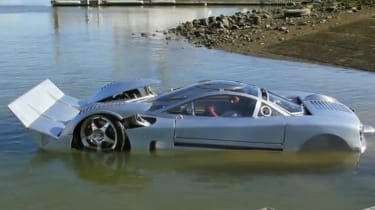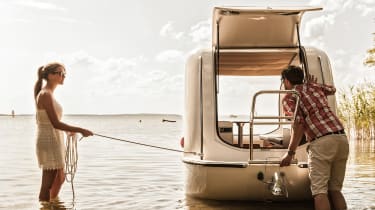Amphibious cars 2018: machines built for the open road and open water
Think you know off-roading? Think again. These water-worthy amphibious cars are the real go-anywhere heroes
Anybody who’s been a bit too ambitious in fording a stream or driving through a particularly large puddle will tell you that cars and water don’t mix. Horror stories of ruined electrics, flooded engines, and mouldy interiors should be enough to scare anybody into keeping their car tyres dry at all times.
Yet throughout history people have been ignoring this gospel and creating cars that can reach the water’s edge and keep on going – amphibious cars, equally at home on dry land or on the water.
• Flying cars: vehicles of the future?
That’s the theory, anyway. Unfortunately for the plucky inventors, amphibious cars tend to be compromised in every way. The end result normally handles like a boat on the road and a car on the water – an awkward halfway house which, while it may do passable impressions of both car and boat, can’t really replace either.
Perhaps that’s why amphibious cars have never made an impression on the buying public. Even the most successful struggled to sell more than a few thousand examples. Despite this, it’s incredibly interesting to see the different approaches taken by different designers attempting the Amphibious car trick – and so we decided to round up our ten favourites, ranging from hydrofoils to submarines...
Scroll down to see our list of the top ten amphibious cars…
Amphibious cars: 10 of the best
Amphicar
We start this list with the only amphibious car worthy of being called a sales success – nearly 4,000 examples of the Amphicar were built between 1961 and 1968, with most finding their way to the USA. One notable owner was President Lyndon B. Johnson, who was said to thoroughly enjoy driving hapless visitors directly into his lake, all the while screaming about brake failure.
The West German Amphicar used the 1.1-litre four-cylinder petrol engine from the Triumph Herald, and mounted it at the rear of the car, where it drove the rear wheels through a four-speed manual gearbox. At the flick of a lever, though, drive was transferred to twin propellers mounted under the rear bumper – endowing the Amphicar with a top speed of 7 knots in the water, where it steered using the front wheels as rudders. It was the Amphicar’s mild steel construction that proved to be its undoing, though – in a product intended to spend a lot of time in the water, rust is the last thing you want to worry about.
Volkswagen Schwimmwagen
From the best-selling amphibious car to the one built in the highest numbers. Though it was purely a German military vehicle, the Beetle-based Schwimmwagens were built in massive numbers – over 14,000 examples from 1942-44.
Used primarily in military exercises in the Second World War, the Schwimmwagen came in two versions – a 128, with a 240cm wheelbase, and a later model with a 200cm wheelbase which would eventually become the full-scale production model. They used mechanicals from the VW Kubelwagen and Type 87 – which themselves inherited a platform from the iconic Beetle – but fitted inside a custom-welded hull.
Drive was to all four wheels, while in the water a screw propeller could be lowered. This only gave forward drive, though, so Volkswagen was thoughtful enough to equip an oar as ‘reverse gear’. Only 163 Schwimmwagens have survived.
Gibbs Aquada
Looking a little bit like a Mazda MX-5 on stilts (and steroids) the Gibbs Aquada is well known thanks to its crossing of the English channel – with none other than Virgin multi-millionaire Richard Branson at the helm.
Despite the looks, though, the Aquada isn’t based on any existing car – it was designed from the ground up to sidestep so many of the compromises associated when turning a car into a boat, or vice versa.
Powered by a 2.5-litre Rover V6 engine, the Aquada is covered by over 60 patents protecting its propulsion systems. It’s impressive on-road, as we found out when we test-drove it over a decade ago – and can hit over 30mph on the water. Still, the lack of a roof or doors and the awkward central driving position mean it’s unlikely to be seen on the school run.
Watercar Panther
Flying the flag for America, the Watercar Panther looks like some crazy union between a Jeep Wrangler and a bathtub – but it’s a winning combination, as the vehicle is capable of 45mph on the water, as well as 80mph on land. This is courtesy of a 3.7-litre Honda engine and a waterjet engine for driving in the water. This combination gives it a Guinness World Record for the fastest amphibious vehicle on sale.
Created using high-tech materials, Watercar describes the Panther as ‘virtually unsinkable’ thanks to over 900 litres of Styrofoam in the hull – it's approved by the US Coastguard, no less. Don’t throw away your family hatchback just yet though, as the Panther costs around $140,000 (over £104,000) and the price can rocket if you specify any personal options.
Dutton Surf
Veteran kit car manufacturer Tim Dutton has produced plenty of great vehicles over his career – Dutton cars was the largest volume kit car company in the world. After leaving his firm, Dutton began producing several amphibious vehicles – and his latest, the Dutton Surf, is the most interesting yet.
Look closely and you might notice a few familiar components – that’s because the Surf is based on that humble off-roader, the Suzuki Jimny. Dutton’s kits will accept parts from any Jimny, and to save money can even use a mildly damaged donor car.
The Surf is capable of 6mph in the water, and to prove its seaworthiness a pair of similar cars crossed the English channel at an average speed of 4.2mph. Dutton will also build you a smaller model using a Ford Fiesta as a donor car – we wonder if the Ford supermini’s class-leading handling will translate to the water…
Rinspeed Splash
The Splash is the creation of the madmen at Swiss company Rinspeed – known for its crazy concept cars. Taking a different approach to the amphibious car, the Splash is actually a hydrofoil – using spoilers and fins to ‘glide’ above the water. It makes for quite a sight, aided by the Splash’s bright blue paintjob and interesting design.
Powered by a 750cc twin-cylinder snowmobile engine, the Splash is designed to run on clean-burning natural gas rather than petrol, and despite the low power output of just 140bhp it can reach 62mph from rest in under 6 seconds. Not too shabby!
Unveiled at the 2004 Geneva Motor Show, the Rinspeed Splash remains one of our favourite concept cars – ever!
Iveco MPC
With their water-to-land and land-to-water capabilities, it should come as no surprise that amphibious vehicles have long been of interest to the military. In this case Iveco - a Fiat Industrial company - combined forces with BAE systems to build 600 of these Marine Personnel Carriers (MPC) for the US Marines.
Based on the Superav 8x8 - a vehicle constructed for the Italian Armed Forces in 2010 - this 27 tonne machine is capable of transporting up to 12 soldiers, and is designed to provide maximum protection against landmines and explosive devices. The last thing you want is a hole in the bottom, after all.
Project Sea Lion
Designed to be the fastest amphibious vehicle on land, Project Sea Lion’s 125mph top speed on the road comes courtesy of a Mazda rotary engine, which also endows it with a nearly 60mph top speed in the water, too.
Looking somewhat like a Koenigsegg supercar, Project Sea Lion’s most striking feature is the massive wing on the front – designed to lift the car out of the water when underway. We can’t help feeling it might struggle over speed humps, though.
Project Sea Lion’s creator says that the chassis and drivetrain of the vehicle are easily capable of beating records, and he’s sure that with the right engine it could reach over 60mph on water and – slightly more terrifyingly – 180mph on land. One willing buyer is certainly ready to try – project Sea Lion sold at auction in 2012 for almost $260,000.
Rinspeed sQuba
There’s more to this Lotus Elise than meets the eye. It is in fact another creation from our friends at Rinspeed, and it’s named the sQuba for a very good reason.
Instead of just floating on the surface, passengers pull a scuba-style oxygen regulator over their heads… and dive underneath the waves. The sQuba is the world’s first submarine-car, and it’s inspired by the iconic Lotus Esprit submarine used by none other than 007 himself.
Of course, unlike Bond’s Esprit, the sQuba actually works – courtesy of an all-electric powertrain in place of the Elise’s engine. On land, top speed is 75mph, while the propellers and twin blow jets can propel it to just 2mph underwater.
Rinspeed first unveiled the sQuba to the public at the Geneva Motor Show in 2008, where it revealed plans to make a production version. Eight years on, we’re still waiting…
Sealander Schwimmcaravan
Taking your car onto the water is all very well, but you can’t really do much when you’re out there. An in-car picnic is pretty unpleasant, after all, and even more so when you’re crammed into something that was never really intended to be seaworthy. Enter the Schwimmcaravan – the world’s first (and so far only) amphibious caravan.
Crafted by boatbuilders in Germany, the Schwimmcaravan can be towed by anyone with a normal car licence by virtue of its lightweight construction. Back it carefully into the water, though, and it becomes a bona fide boat – propelled by an outboard motor.
With room to seat six and sleep two, the prospect of parties on the water could be reality with Sealander’s Schwimmcaravan. Just be careful – too much rocking and things could get very wet indeed!
Would you ever consider owning an amphibious car? Tell us why not in the comments section below...
